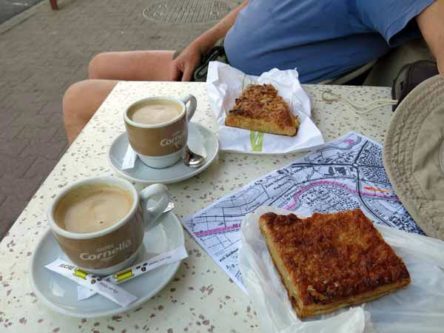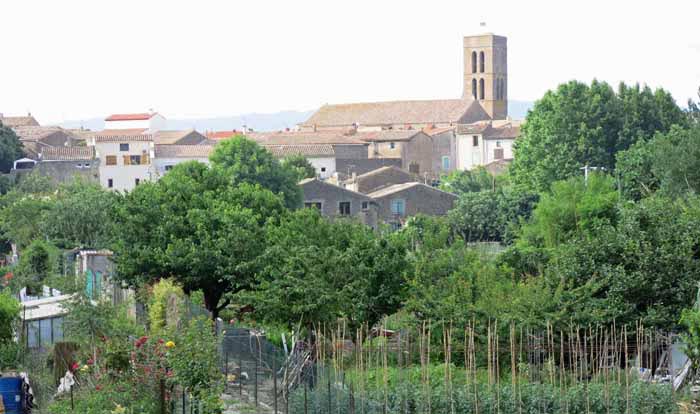Monday, 15 June 2015
Distance 16 km
Duration 4 hours 0 minutes
Ascent 64 m, descent 57 m
Map 174 of the
Last night we had taken the precaution of asking what time the three eateries opened, and had been disappointed three times – the earliest was 9:30 am.
So this morning we decided to set off unfed and hope for the best. At the very least we would get something comforting at the boulangerie.
No sooner were we over the bridge than we came to a bar that we must have walked past without noticing the day before, just a doorway with a couple of tables out on the pavement.
Inside, several heavily built and thickly moustached Turkish men were propping up the counter, and I chatted with one of them while Keith dashed up the street to get pastries.
When this fellow found out I was Australian, he surprised me by saying that his daughter was presently studying in Perth.
He then gave me an indignant account of the sins of the French government, and declared that he would move to Australia if he were twenty years younger. I didn’t bother telling him about our appalling government.
We sat outside for this delightful, unexpected breakfast and got moving in earnest at about 8:30.
Our plan was very simple – to follow the canal till we got to Carcassonne. There was no pathfinding required but we had detailed maps as usual, and it was interesting to keep track of which bend of the canal we were up to.
Canal walking, although beautiful, can become monotonous, but this year I had a secret weapon, an iPod. On this I had installed a long series on the history of Rome (by Mike Duncan), and this kept me entertained for the whole five weeks of our journey.
Leaving the town, the canal crossed the tiny river Orbiel, lined with vegetable gardens and fruit trees, and went through a barren section where diseased plane trees had been removed.
There were notices informing us of the recent replanting program and of its cost – €61,786.32. We particularly liked the 32 cents on the end.


Soon after that the canal re-entered the shelter of the trees. Not all of them were plane trees – there were beautiful oaks and pines as well – but the smooth, pale trunks and spreading canopy of the planes made them the most beautiful of all.
A few cyclists glided past and we even saw another pair of walkers. These ones were French and were heading for Montpellier via the national park, presumably the wilderness that we had got lost in on our way to Bizanet (unless it was the mountainous Haut-Languedoc).
We sauntered along past a couple of stone bridges and unmanned locks, and less than two hours after leaving Trèbes we arrived in the outskirts of Carcassonne, at the high double lock of Fresquel, where boats were lined up waiting to go through.
Here the canal turned sharply and we saw the town in the distance.
According to our map, the GR crossed to the other side of the canal for the last kilometre into the centre, so we dutifully left the well-defined towpath and went over a bridge onto a dusty track. This kept close to the bank for a short distance, then fizzled out.
Our only choice (apart from going back, which we hate to do) was to follow the track up onto a hillside of dry grass, where we could see houses ahead.

An old woman walking with her dog gave us directions to the centre of town, and added that this hillside was the best place to be on Bastille Day, to see the fireworks in the Cité.
She pointed to the Cité floating like a mirage on a high ridge beyond the town, its many conical towers gleaming through the haze of distance.
It took us an unedifying half hour to trudge up through the suburban streets and down to the railway station, at which point we rejoined the canal.
We were very pleased to see it again after our little aberration.

Some of the streets leading off from the port into the old town were reserved for pedestrians and we joined a throng of people strolling along a fashionable shopping lane until it opened out into a large cobbled square (Place Carnot), with a fountain in the middle and cafés all around, shaded by umbrellas and young plane trees.
Here we had a classic second breakfast of croissants and coffee, while people around us were ordering lunch – it was midday by now.
We still had two kilometres to go to the camping ground, so in due course we set off again, towards the river. The square grid layout of the streets, so different from most villages, made us wonder whether the town was a bastide, and later that day we learned that it was, and also why it was built.

Along the way we stopped at the Office of Tourism and discovered that they had internet access. We needed to send an email, but decided to come back later, as they were open until
After crossing the Aude on a hump-backed stone footbridge (le Pont Vieux) at the base of the citadel, we continued for a kilometre or so along a road, then on a tree-lined path beside a minor branch of the river, and came out at the camping ground.
This was a fine establishment with a shop, a restaurant, a covered terrace and great sweeping grounds.
Walkers and cyclists were sent to a reserved area at the bottom, and we were amazed to see several small tents already occupying it – normally we are the only small tent in sight.
After showers, which were particularly good as they had adjustable temperature, we had a rest, but no lunch – we seemed to have lost our appetite in the middle of the day. Then we set off for the town again to send our email.
As we passed the camping restaurant, we looked at the menu and decided to come back and eat there in the evening, instead of making the long trip to town yet again.

Having sent the email, we strolled over the Pont Vieux and took the long sloping cobbled way up to the Cité, then went in through the great stone portal.
This is one of the most famous tourist sights in France and is the biggest mediaeval town in Europe which still has its encircling walls.
The hilltop that it stands on has been occupied continuously since Neolithic times, owing to its strategic position at the intersection of two important trade routes – the one between the Atlantic and the Mediterranean, and the other from the Pyrenees to the Massif Central.
In 1209 the Cité was besieged by French troops, ostensibly to crush the heresy of Catharism, whose sin was to view God and the devil as two equal and opposing forces.
It was a form of Christianity that was widespread in Languedoc, which at the time was not part of France. Clearly there was more than a whiff of territorial greed in the religious zeal of the French.
This campaign, sponsored and blessed by the church, was known as the Albigensian crusade, by analogy with the crusades to the Holy Land.
Carcassonne was the centre of the resistance, and the Cathar castles in the high Corbières were known as “daughters of Carcassonne”.
After the defeat of 1209, Carcassonne became the property of the king of France. A genocidal program of sieges, massacres and burnings continued until Catharism was completely obliterated.
In 1247 the exiled former citizens were allowed to return, but not to the Cité itself, as it was considered too defensible.
King Louis IX ordered a new, low town built on the other side of the river, in the square bastide style typical of the age, with the Place Carnot as its centre.
Later the Cité fell into disrepair and in the nineteenth century it was about to be demolished, but was saved and heavily restored by Violet-le-Duc.
We wandered about the lanes, accompanied by crowds of other sightseers, admiring the turretted guard towers, the great studded doors, and the massive stone walls, parts of which go back the Gallo-Roman era.
It was certainly impressive but there was a whiff of theme park about it which the many gift shops, cafés and hotels did not lessen.
On the descent we took a different sloping way and soon rejoined the path to the camping ground. We arrived at
It was at this point that we saw the notice attached to the menu – on Mondays and Wednesdays, the chef’s days off, the restaurant only served chips, chicken nuggets or calamari (and it was Monday).
They all sounded vile but we could not face walking all the way back to town, so we decided to go to the shop and get a tin of lentils and a bottle of wine to eat next to our tent.
But first we ordered a pastis and a rosé and settled in on the terrace, where a few others were already eating.
Before long we noticed that some people were getting pizza, so we ended up having that, and it turned out remarkably pleasant, with a carafe of local red wine and the sun on our backs.
Previous day: Capendu to Trèbes













